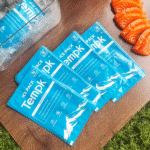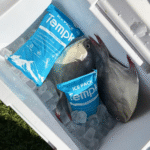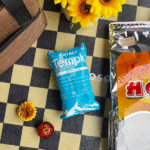Dryidrepackcells36pack: Devriez-vous mettre à niveau votre expédition gelée?
Expédition des aliments surgelés ou des biologiques? UN Dryidrepackcells36pack offre modulaire, –78 ° C refroidissement qui dure 72 heures mais s'adapte aux doublures standard. Ce livre de jeu vous montre de charger des formules, choix d'équipement, et 2025 Règles pour ne plus jamais jouer avec le risque de dégel.

-
Comment un pack de glace sec à 36 cellules surpasse-t-il les granulés en vrac?
-
De combien de packs avez-vous besoin pour 24, 48-, et 72 heures?
-
Quels refroidisseurs se marient le mieux avec de la glace sèche à base de cellules 2025?
-
Quelle sécurité, patrie, et les étapes d'élimination gardent les équipes conformes?
-
Comment pouvez-vous mélanger des packs de gel avec des unités à 36 cellules pour les voies hybrides?
Qu'est-ce qu'un drydicepackcells36pack?
Un pack de glace sec à 36 cellules est une feuille perforée de 36 mini blocs (≈25 g chacun) scellé dans un film respirant qui éveille le co₂ tout en verrouillant la forme. Contrairement aux pépites lâches, Les cellules restent à plat, empiler soigneusement pour maximiser le contact de surface et la sublimation de la caisse de ~ 12%.
Spécifications typiques:
| Attribut | Valeur | Avantage |
|---|---|---|
| Taille de la cellule | 40 × 40 × 15 mm | Même la grille de refroidissement |
| Poids net | 900 g | Mathes de charge prévisibles |
| Taux de ventilation | 0.8 Lco₂ / h | Rencontre iata pi954 |
De combien de packs à 36 cellules avez-vous besoin?
Règle: une feuille par charge utile congelée de 1 kg pour 24h; Deux feuilles pour 48h; trois pour 72h. Packs de calques en haut—Chold des coule vers le bas.
| Charge utile surgelée (kg) | 24 Histes H | 48 Histes H | 72 Histes H |
|---|---|---|---|
| 2 | 2 | 4 | 6 |
| 5 | 5 | 10 | 15 |
| 10 | 10 | 20 | 30 |
Comptoir: Pré-Chill la boîte à –20 ° C pour 3H pour prolonger le temps de maintien de 10 à 15%.
Pourquoi passer à des packs à 36 cellules sur les pastilles?
-
Refroidissement uniforme: Les cellules distribuent –78 ° C uniformément, Couper des points chauds.
-
Chargement plus rapide: Les draps glissent comme des boîtes à pizza - pas de pellets qui courent.
-
Uncoucheur plus propre: Les utilisateurs finaux gèrent une feuille bien rangée, pas des fragments lâches.
-
Poids des dangers inférieur: Des feuilles modulaires vous permettent de rester sous l'exemption de la compagnie aérienne de 2,5 kg.
Exemple de terrain
Une marque de gelato spécialisée a remplacé les pellets par cinq feuilles de 36 cellules par commande de 4 kg et a chuté des réclamations de fonte de 7% à 1% lors des livraisons d'été de 48 h.
Appariement plus frais & Conseils de superposition
-
Valeur R ≥4 m² / w doublures (aérogel ou VIP) sublimation lente.
-
Utiliser un entretoise ondulée entre le produit et la calotte glaciaire.
-
Remplissez les vides avec des coussinets en papier recyclables pour une meilleure efficacité thermique.
Sécurité & Conformité: 2025 Liste de contrôle
-
Étiqueter «UN1845 glace sèche» + Poids net sur deux faces.
-
Gardez la glace sèche totale ≤ 2,5 kg par boîte pour ignorer les documents complets de classe 9.
-
Zone de ventilation de 20 à 30 mm²; Le film de la feuille est déjà des micro-ventes co₂.
-
Se porter lâche, gants isolés - le contrôle des gelures se produit dans < 5s.
-
Laisser les feuilles restantes sublime dans un espace bien ventilé; Recycler le film où accepté.
Après ces étapes, répond aux normes 49CFR et IATA PI954.
2025 Tendances: Plus intelligent, Glace sèche à base de cellules vertes
-
Co₂ capturé de brasserie Feuilles maintenant des feuilles de glace sèche en carbone., Empreinte rétréci 28%.
-
Tags NFC bi-directionnels intégré dans les coins en feuille de la température de journal et de taux de sublimation.
-
Films à base de plantes compost en 180 jours sans perte de performance.
Les données du marché montrent que les packs de glace sèche modulaires gagnent 11 % part de marché sur des pastilles comme des flocons congelés de commerce électronique.
FAQ
Puis-je réutiliser une feuille de 36 cellules après qu'elle sublimait?
Oui - Refill Services Reload Co₂ dans les films retournés, couper les déchets.
Les cellules transpirent comme des packs de gel?
Pas de liquide; Les feuilles sublimatent directement au gaz, Garder les boîtes à sec.
Les feuilles de 36 cellules sont-elles sans danger pour le fret aérien?
Moins de 2,5 kg par paquet avec emballage ventilé est entièrement conforme à la compagnie aérienne.
Résumé & Étapes suivantes
Le Dryidrepackcells36pack offre une commodité à plat, refroidissement cohérent –78 ° C, et un déballage sans tracas. Suivez le graphique de chargement, Associez une isolation élevée, et regarder une chute de détérioration inférieure à 2% sur les voies de 72 heures.
Plan d'action:
-
Estimer le nombre de feuilles avec notre calculatrice en ligne.
-
Demander un échantillon (5, 10, 15 feuilles).
-
Exécutez un test de voie - Données de transfert pour un crédit de réorganisation de 10%.
À propos
Nous concevons des solutions thermiques recyclables qui battent la mousse volumineuse. Nos doublures Aeroflex ™ et les feuilles de glace sèche à 36 cellules gardent la cargaison à –30 ° C pour 60h mais se repliez à plat pour l'expédition de retour.
Besoin de conseils? Réservez une consultation gratuite.























